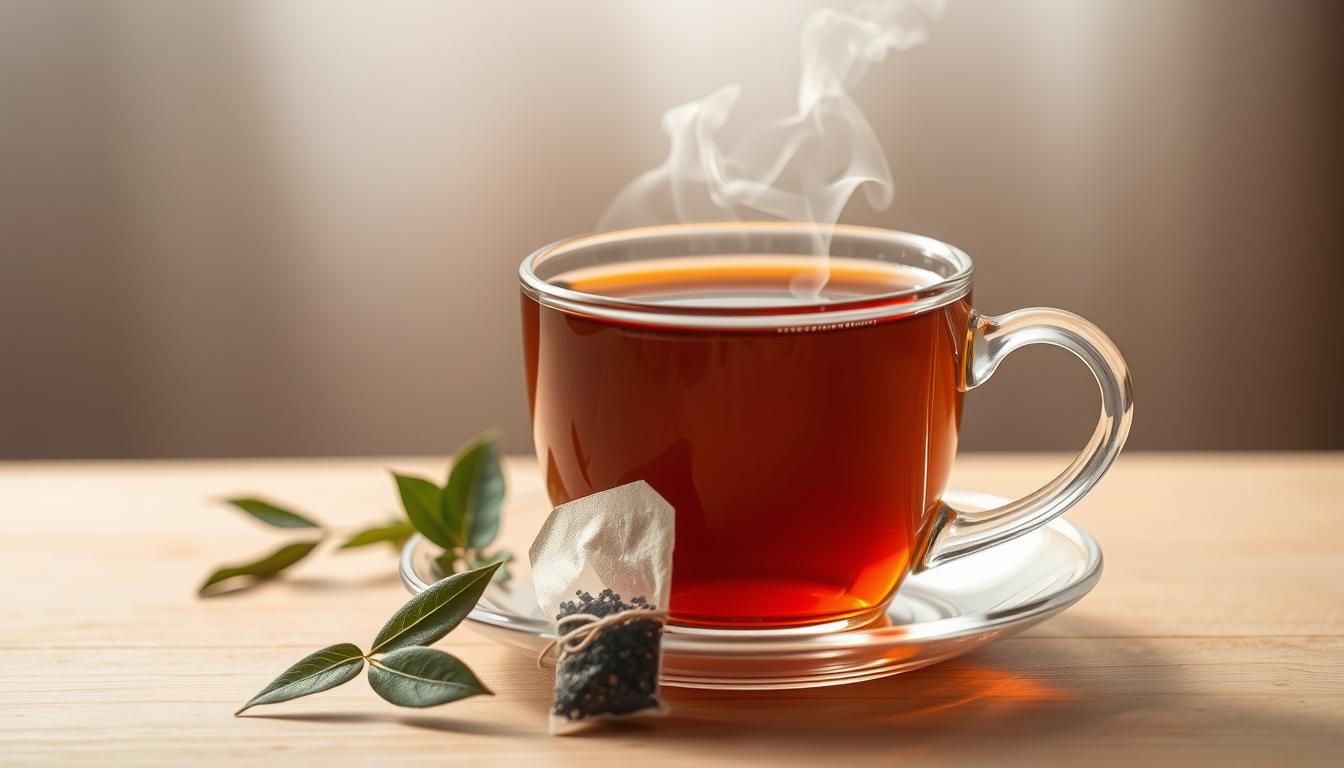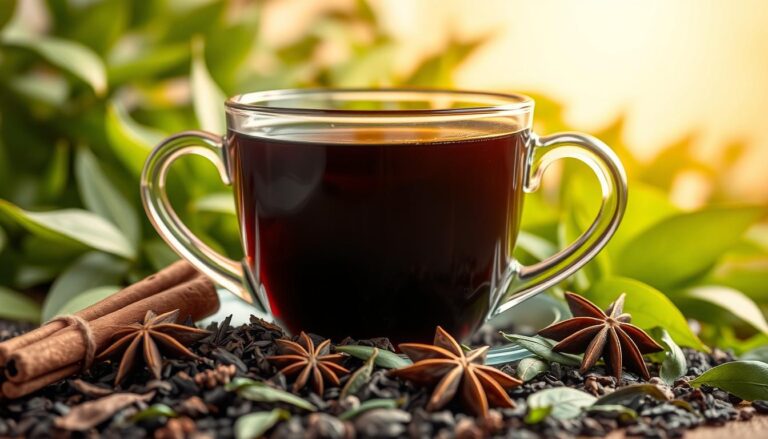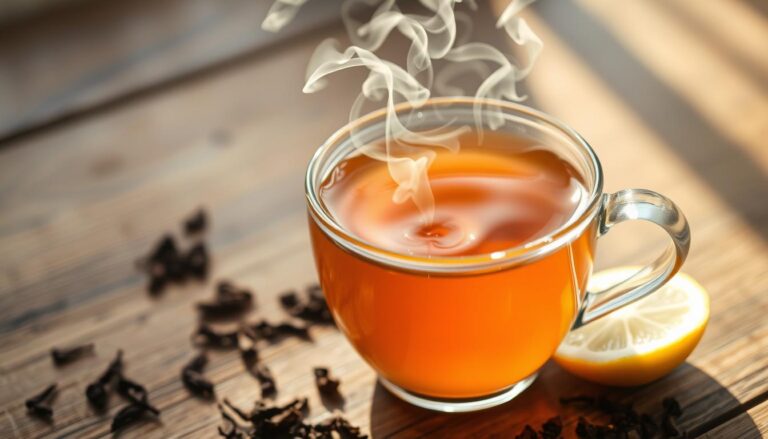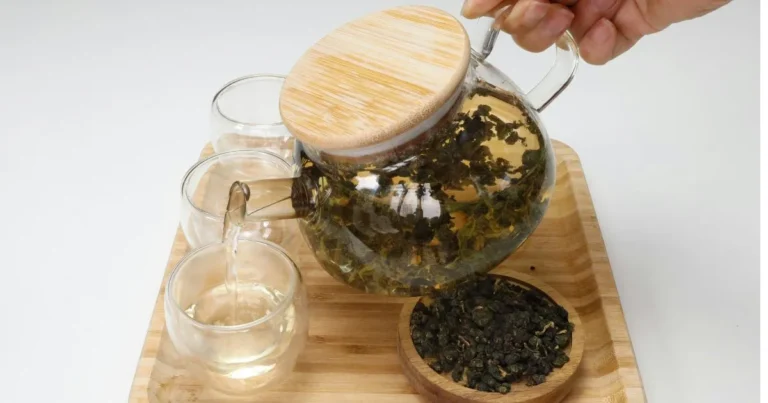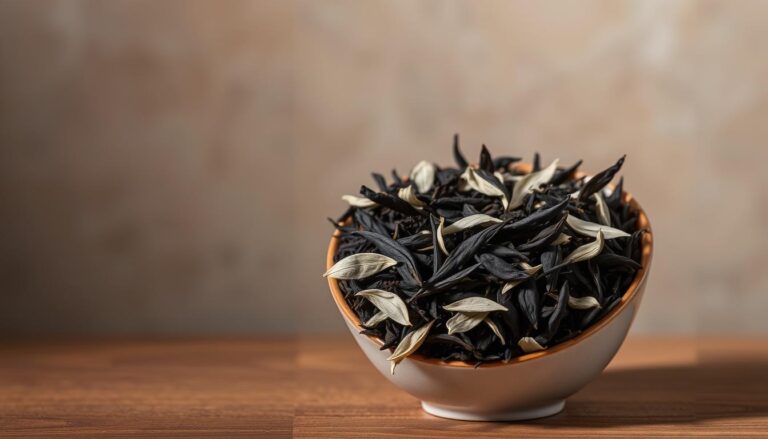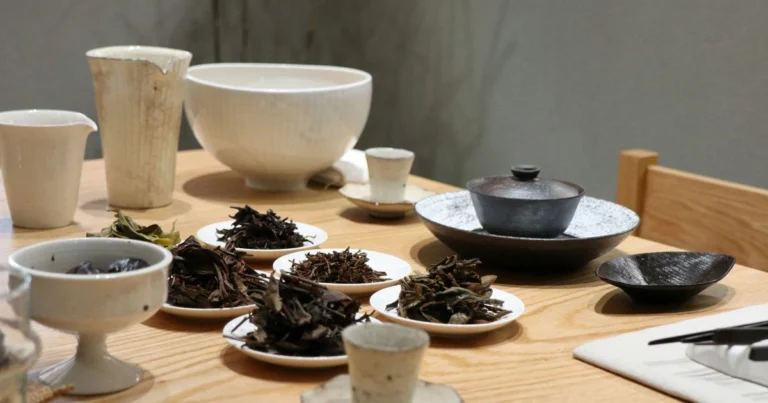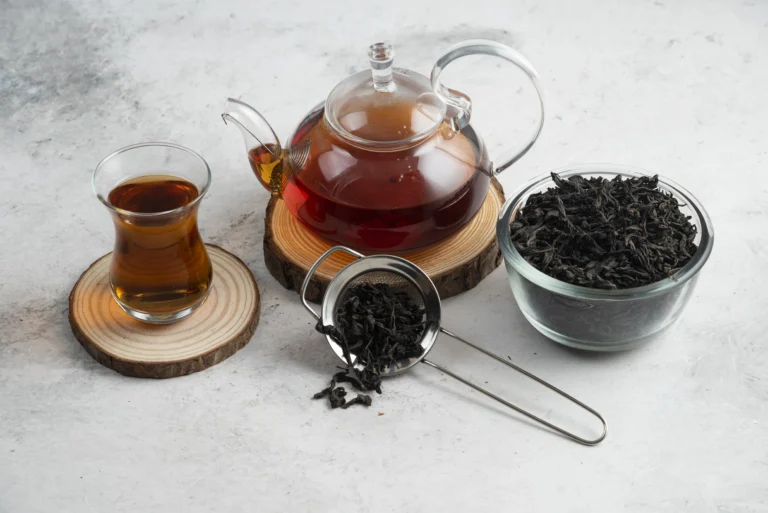Does Earl Grey Tea Have Caffeine? 5 Things You Didn’t Know
You sip your Earl Grey tea, savoring the soothing citrus aroma of bergamot. But a question lingers, does Earl Grey tea have caffeine? You’re not the only one curious. Many tea lovers wonder about the caffeine levels in this classic brew.
As Nourish by WebMD notes, an 8-ounce cup contains between 40 and 120 milligrams of caffeine. This gives you a general sense of what’s in your cup. Keep reading to discover five surprising facts about Earl Grey tea’s caffeine content — knowledge that can help you make smarter choices about your daily tea habit.
Table of Contents
Understanding Earl Grey Tea’s Composition
To grasp the caffeine in Earl Grey tea, we must first understand its makeup.
Earl Grey tea is a flavored black tea. It combines the strong taste of black tea with the citrusy flavor of bergamot oil.
What Is Earl Grey Tea?
Earl Grey tea is a flavored black tea. It’s famous for its unique taste and smell, thanks to bergamot oil.
The tea is named after Charles Grey, a British Prime Minister from the 19th century.
Common Ingredients in Earl Grey
The main parts of Earl Grey tea are:
- Black tea leaves: The base is usually a strong black tea, like Assam or Ceylon.
- Bergamot oil: The flavor and aroma come from bergamot orange oil.
Some recipes might add lavender or lemon. But the classic recipe is straightforward.
How is Earl Grey Made?
Making Earl Grey tea involves:
- Selecting the tea leaves: High-quality black tea leaves are picked first.
- Adding bergamot oil: Bergamot oil is then added to the tea leaves. This can be done by spraying the oil or mixing it in during blending.
- Blending: The tea is blended to spread the flavor evenly.
This process creates a tea that’s both strong and flavorful. It has a unique citrus taste.
The Caffeine Content of Earl Grey Tea
Knowing how much caffeine is in Earl Grey tea helps you choose wisely. This tea, famous for its bergamot flavor, has caffeine. It can boost your energy and alertness.
Comparing Earl Grey to Black Tea
Earl Grey tea is made from black tea leaves. These leaves have a strong flavor and caffeine. The caffeine in Earl Grey is similar to other black teas, with 40 to 120 milligrams per 8-ounce cup.
The type of black tea used affects caffeine levels. Teas from Assam or Ceylon have more caffeine than Darjeeling.
How Does Brewing Time Affect Caffeine?
The brewing time changes how much caffeine is in your tea. Longer brewing times mean more caffeine. For Earl Grey, 3 to 5 minutes is best for flavor and caffeine.
“The art of brewing tea is not just about the time; it’s about understanding how different factors like temperature and tea leaves interact to give you the perfect cup.”
To control caffeine, adjust the brewing time. Steep for 1 to 3 minutes for less caffeine. Steeping for up to 5 minutes makes the tea stronger but increases caffeine.
Health Benefits of Earl Grey Tea
Earl Grey tea is more than just a favorite among tea lovers. It’s also full of health benefits. Like other black teas, Earl Grey contains antioxidants that protect against health problems.
Antioxidants and Health Impacts
Earl Grey tea is loaded with antioxidants. These are key for keeping our health in check. They fight off free radicals, which can harm cells and lead to diseases. Drinking Earl Grey tea often may lower blood pressure and cholesterol, cutting down heart disease risk.
The antioxidants in Earl Grey tea also have anti-inflammatory effects. This can help prevent chronic diseases like cancer and neurodegenerative disorders.
Effects on Mental Alertness
Earl Grey tea does more than just good for your body. It also boosts mental alertness. The caffeine in it helps you stay alert and focused, perfect for a morning or afternoon pick-me-up.
The bergamot aroma in Earl Grey tea can calm your mind. It helps reduce stress and anxiety. This mix of caffeine and bergamot makes Earl Grey tea great for mental clarity and well-being.
| Health Benefit | Description |
|---|---|
| Antioxidant Properties | Rich in antioxidants, which help protect against cell damage and chronic diseases. |
| Heart Health | May help lower blood pressure and cholesterol levels, reducing the risk of heart disease. |
| Mental Alertness | Caffeine content can increase alertness and focus, while bergamot aroma may help reduce stress and anxiety. |
Factors Influencing Caffeine Levels
Did you know that the type of tea leaves and blend variations can change the caffeine in Earl Grey tea? Knowing these factors helps you choose the right tea for you.
Type of Tea Leaves Used
The type of tea leaves in Earl Grey tea affects its caffeine. Black tea leaves, used in Earl Grey, have more caffeine than green tea. But they have less than Assam or Ceylon tea. The specific tea and brand can also change the caffeine levels.
Black tea, the usual base for Earl Grey, has 40-70 mg of caffeine per 8 oz cup. But, the quality and brand can affect this amount.
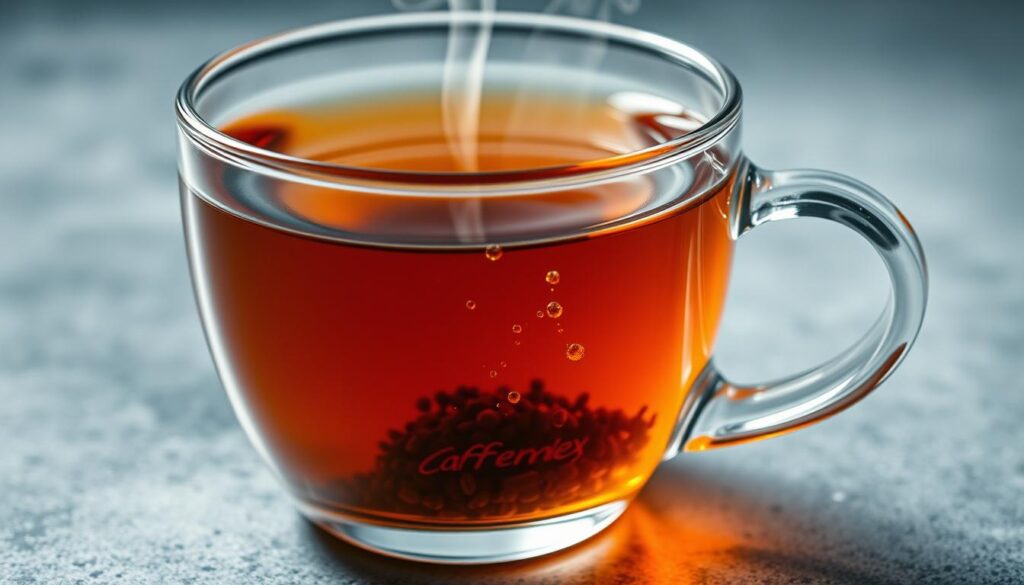

Blend Variations and Caffeine Content
Blend variations can also change Earl Grey tea’s caffeine. Some blends might have extra ingredients or different tea leaf ratios. For example, a stronger blend with more leaves will have more caffeine.
| Blend Type | Caffeine Content (per 8 oz cup) |
|---|---|
| Standard Earl Grey | 40-70 mg |
| Stronger Blend Earl Grey | 70-100 mg |
| Decaf Earl Grey | 2-12 mg |
Decaffeinated Earl Grey Tea Options
You don’t have to give up flavor for a caffeine-free diet. Decaffeinated Earl Grey tea is here to show you that. It’s perfect for Earl Grey fans who are sensitive to caffeine or want to cut down on it.
What to Expect from Decaf Earl Grey
Decaffeinated Earl Grey tea keeps the same taste as regular Earl Grey. The bergamot flavor still pairs well with the black tea. The caffeine is mostly removed, making it safe to drink anytime, even for those who can’t handle caffeine well.
The taste of decaf Earl Grey is very close to the regular version. Some might notice a slight difference, but the overall experience is still great. The aroma and soothing effects are mostly the same.
Popular Brands Offering Decaf Earl Grey
Many well-known tea brands offer high-quality decaf Earl Grey tea. Some of the most popular ones are:
- Harney & Sons
- Tazo
- Teavana
- Celestial Seasonings
- Bigelow
These brands are known for their quality and flavor. When picking a decaf Earl Grey, look at the brand’s decaffeination method. This ensures it meets your preferences.
| Brand | Decaffeination Method | Price Range |
|---|---|---|
| Harney & Sons | Swiss Water Process | $5-$10 |
| Tazo | CO2 Process | $4-$8 |
| Teavana | Swiss Water Process | $6-$12 |
| Celestial Seasonings | Indirect Solvent Process | $3-$6 |
| Bigelow | CO2 Process | $4-$8 |
Choosing decaf Earl Grey from trusted brands lets you enjoy Earl Grey tea without caffeine. It’s great for anyone looking to cut down on caffeine or prefer a cup in the evening.
The Flavor Profile of Earl Grey Tea
Earl Grey tea is a mix of black tea and bergamot oil. This mix makes Earl Grey taste citrusy and slightly sweet. The taste can change based on the black tea and bergamot oil used.
Key Flavor Components
The main flavors in Earl Grey tea are:
- The strong taste of black tea, which is the base.
- The citrusy flavor from bergamot oil, adding brightness.
- A hint of sweetness, balancing the tea’s bitterness and citrus acidity.
Together, these flavors make Earl Grey tea’s unique taste.
The Role of Bergamot in Flavor
Bergamot oil is key to Earl Grey’s flavor. It’s made from bergamot oranges and gives the tea its citrus taste. The right amount of bergamot oil, between 0.5% to 2.5%, makes the tea smooth and refined.
Some important points about bergamot in Earl Grey are:
- Flavor Enhancement: Bergamot oil makes the tea’s flavor more complex and interesting.
- Aromatic Quality: The citrusy aroma of bergamot oil enhances the tea’s overall taste.
- Balancing Bitterness: Bergamot’s acidity balances the black tea’s bitterness, making the taste smoother.
Popular Earl Grey Tea Varieties
The world of Earl Grey tea is vast, with many traditional and modern variants. Each variety has its unique characteristics and flavor profiles. You can find something to suit your taste buds.
Understanding the differences between traditional and modern variants is key. Traditional Earl Grey tea combines black tea and bergamot oil. This gives it a distinct flavor and aroma. Modern variants, however, may include additional ingredients or use different tea leaves.
Traditional vs. Modern Variants
Traditional Earl Grey tea is a classic choice. It has a strong black tea flavor and citrus notes from the bergamot. Modern variants offer a range of flavors, from subtle to bold. They may include fruits, flowers, or spices.
Some popular modern variants include:
- Earl Grey with lavender
- Earl Grey with lemon
- Earl Grey with rose petals
These unique blends can enhance the flavor profile of the tea. They offer a refreshing twist on the traditional Earl Grey.
Unique Blends to Explore
If you’re looking to try something new, there are many unique Earl Grey blends available. Tea brands offer creative combinations that can enhance your tea-drinking experience.
Here’s a comparison of some popular Earl Grey tea varieties:
| Tea Variety | Main Ingredients | Caffeine Level |
|---|---|---|
| Traditional Earl Grey | Black tea, bergamot oil | Medium to high |
| Earl Grey with lavender | Black tea, bergamot oil, lavender | Medium |
| Earl Grey with lemon | Black tea, bergamot oil, lemon | Medium to high |
| Earl Grey with rose petals | Black tea, bergamot oil, rose petals | Medium |
You can choose a tea variety that suits your taste preferences and caffeine needs. Some tea brands also offer decaffeinated options. These can be a good choice if you’re sensitive to caffeine.
Brewing Tips for the Perfect Cup
Mastering a few simple brewing tips can elevate your Earl Grey tea experience. It’s all about finding the right balance between flavor and caffeine content. Adjusting a few key factors can make your cup perfect for your taste.
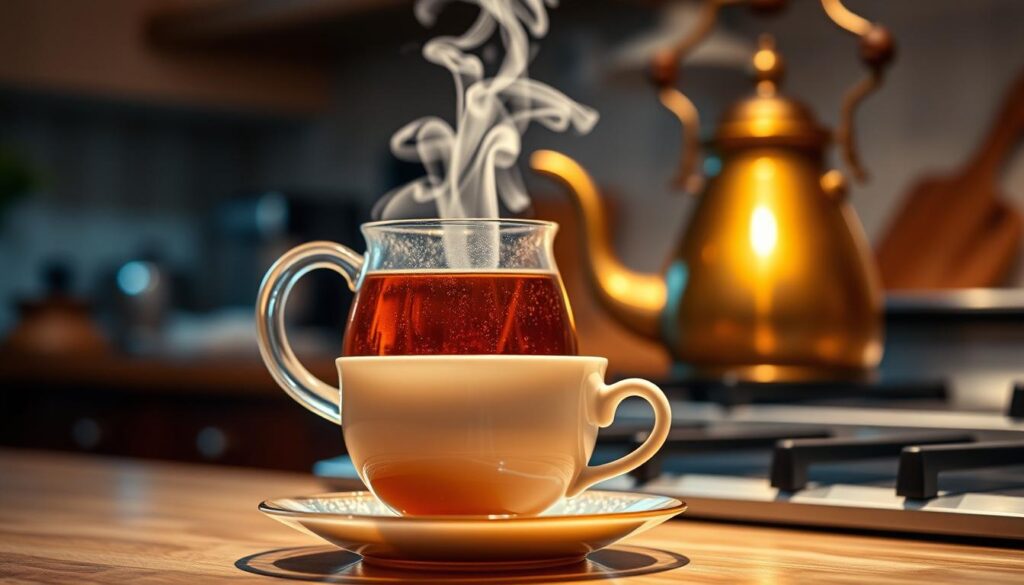

Ideal Water Temperature
The perfect water temperature for Earl Grey tea is between 176°F and 185°F. This temperature range brings out the tea’s flavors without bitterness. Water that’s too hot or too cold can ruin the taste.
Recommended Steeping Times
Steeping time is crucial for Earl Grey tea. Steep for about 5 minutes for the best flavor. Steeping too short makes the tea weak, too long makes it bitter. Adjust the time to your liking for strength and flavor.
Follow these brewing tips for a balanced Earl Grey tea. You’ll enjoy its unique flavor and Earl Grey tea caffeine content in every sip.
Pairing Earl Grey Tea with Foods
Enjoying Earl Grey tea is even better with the right food. Its unique flavor, with citrus notes from bergamot, pairs well with many dishes.
Start by pairing Earl Grey with breakfast items. The citrus flavor of bergamot goes well with both sweet and savory breakfast foods.
Breakfast Options
For breakfast, try Earl Grey with lemon scones or croissants. The citrus notes in the tea bring out the flavors of these buttery pastries. You can also enjoy Earl Grey with fresh fruit or yogurt parfait. The tea’s citrus flavor won’t overpower the taste of these dishes.
Afternoon Snacks
In the afternoon, Earl Grey tea is great with snacks. Biscotti or shortbread cookies are classic choices. For a lighter option, try Earl Grey with almond macarons or fruit tarts. The tea’s bergamot flavor complements the sweetness without overwhelming it.
Try different pairings to find your favorite Earl Grey tea experience. Whether it’s breakfast or an afternoon snack, the right pairing makes a big difference.
Common Misconceptions About Earl Grey Tea
Many people think Earl Grey tea has a lot of caffeine and health benefits. But, it’s often misunderstood. This leads to confusion among those who drink it.
These misconceptions come from not knowing what’s in Earl Grey tea. We’ll look at the caffeine and health benefits myths.
Misunderstanding Caffeine Levels
Some think Earl Grey tea has a lot of caffeine. It’s true that it’s made from black tea, which has caffeine. But, how much caffeine it has can change a lot.
For example, the caffeine in Earl Grey tea can vary. It depends on the brand, how long you brew it, and the tea leaves.
Here’s a comparison of caffeine in Earl Grey tea and other teas:
| Tea Type | Caffeine Content (average) |
|---|---|
| Earl Grey | 40-70 mg per 8 oz cup |
| Black Tea | 60-90 mg per 8 oz cup |
| Green Tea | 25-30 mg per 8 oz cup |
Earl Grey tea has a moderate amount of caffeine. This makes it a good choice for those watching their caffeine intake.
Myths About Health Benefits
There are also myths about Earl Grey tea’s health benefits. It does contain antioxidants, which are good for you. But, some claims about its benefits are not true.
Some think Earl Grey tea can cure or prevent diseases because of its antioxidants. Bergamot, a key ingredient, has been studied for health benefits. But, more research is needed to confirm its effects.
It’s important to know what’s true about Earl Grey tea’s health benefits. While it’s healthy, it’s not a magic cure-all.
Conclusion: Does Earl Grey Tea Have Caffeine?
Earl Grey tea’s caffeine content depends on several things. These include the type of tea leaves and how long you brew it. Bergamot adds to the tea’s taste, but it doesn’t change the caffeine levels.
Caffeine Levels and Responsible Consumption
Be careful with your caffeine intake if you’re sensitive to it. Earl Grey tea’s caffeine can vary. But drinking it in moderation is usually safe.
You can enjoy Earl Grey tea as part of a healthy diet. It has a unique taste and might offer health benefits too.
Enjoying Earl Grey Tea
Try different brewing times and flavors to enjoy Earl Grey tea fully. You can match it with various foods, from breakfast to snacks. Exploring Earl Grey tea can be fun and rewarding.

